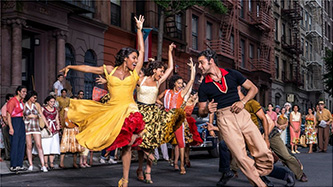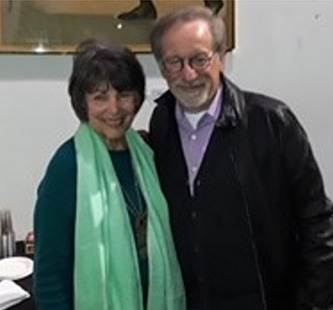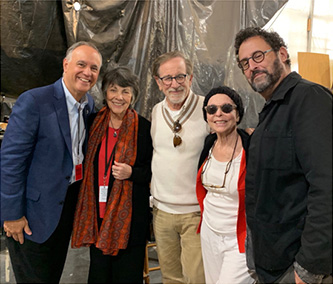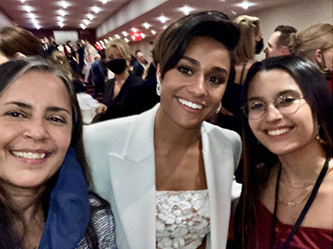Department Highlight: Puerto Rican and Latino Studies

Scene from West Side Story (2021) featuring Ariana DeBose. Photo credit WABC News
The Puerto Rican and Latino Studies Department (PRLS) designed and launched a landmark educational experience for their Fall 2021 offering of PRLS 2105, New York Latinx Culture and the Arts, one of the intercultural competency courses in the Brooklyn College general-education curriculum. The course explores the development of contemporary Puerto Rican/Latinx arts, performance, theater, drama, and expressive cultures in New York City, focusing on creative communities and cultural institutions, and how both are affected by Latinx social life in New York. Taking advantage of the virtual platform of instruction necessitated by the pandemic, last fall the course incorporated a guest lecture series entitled, West Side Story (WSS): The Brooklyn Connection. The course and the lecture series were organized by Virginia Sánchez Korrol, professor emerita of PRLS, who served as a historical consultant to the new West Side Story, and Professor Maria Pérez y González, former chairperson of the department and the instructor for the course.

Professor Emerita Virginia Sánchez-Korrol with Director Steven Spielberg
The lecture series featured special guests connected with the film who shared their expertise, experiences, and insight with students who got the chance to engage not only in the socio-historic background and creative artistry of the movie, but the ins and outs of making a blockbuster musical with one of Hollywood’s most famous directors, Steven Spielberg, and one of Broadway’s most famous playwrights, Tony Kushner. In addition to Spielberg and Kushner, other invited guest speakers included Bobby Sanabria, percussionist, music producer, and arranger, who composed “West Side Story Re-imagined,” a Latin jazz score for the 50th anniversary of the original Leonard Bernstein score; Ernesto Acevedo Muñoz, author of West Side Story as Cinema: Making an American Masterpiece (University Press of Kansas, 2013); Professor Juan González, journalist and activist, who spoke about racism, the Young Lords, gangs, and family; Jeanine Tesori, one of Broadway’s most honored and productive musical composers; and Victor Cruz, actor and producer who spoke about his path as an actor and becoming a Spanish diction coach for the movie.

(From left) CUNY Chancellor Felix Matos Rodriguez, Virginia Sánchez-Korrol, Steven Spielberg, Rita Moreno, and Tony Kushner
The course explored the artistic and cultural impact of West Side Story through the lenses of the humanities and social sciences, highlighting Puerto Rico’s history within the USA, (im)migration, ethno-racial relations, gender, gangs, language, music, church, and other issues. Both Sánchez-Korrol and Pérez y González were pleased with the way the lecture series and the course turned out. Sánchez-Korrol was particularly pleased with the educational outcomes engendered by the format. She wrote: “I think what impressed me about our WSS Lecture Series from an educational perspective was that in this time of COVID and virtual teaching, the presentations, which were deliberately embedded in an undergraduate course in PRLS, generated overwhelming attendance, engagement and excitement.”
Thinking in terms of its practical applications for students, Pérez y González explained that the series “was created to be useful for our students to provide insight and information that they would not otherwise know, like how to analyze a film and its impact on society while also learning from the experts about the creative arts/entertainment industry.” She also noted that by opening up the online lectures to the campus community, particularly the School of Visual Media and Performing Arts and the Feirstein Graduate School of Cinema, along with numerous other campus entities, universities, secondary schools, and other cultural organizations, the course incorporated many markers of success. In noting one of those achievements, Sánchez Korrol remarked: “Essentially, we were able to introduce non-PRLS students and colleagues to our department and its interdisciplinary format as well as the expertise of our faculty, hopefully engendering understanding and future collaborations across disciplines.” She also pointed out that “the format offers an exciting pedagogical tool that works well for distance and interdisciplinary courses. When we decided to create the series, we knew it was to be educational, and not a promo for the film. As it turned out, the series worked beyond expectations.”

Pérez y González (left) and her daughter Daniela (right) with Oscar winning WSS star, Ariana DeBose (center)
Pérez y González also noted that their planned course was a welcome relief from the routine virtual classroom/office/meetings/work and that everyone connected to the series and the course was excited leading up to the film’s release that December. With the news that Puerto Rican and Latinx actors and dancers had been cast for all of the Puerto Rican parts in the film and would actually speak Spanish, that Rita Moreno would return to the film as a new character, and that lyrics of the revolutionary national anthem of Puerto Rico would be sung, she noted that everyone was “anxious to see how it would all come together!”
The organizers saw the lecture series as a way to tie the academic to the practical for the purpose of educating students in many ways at once. Pérez y González explained that the series would add another dimension to the course by “broadening the knowledge base” through uncovering the processes that activate the creative arts and entertainment industry, and opening up new knowledge pathways into how the arts and the entertainment industry intertwine. Furthermore, the professors believed that, it would be an interesting way to highlight what an interdisciplinary department such as PRLS can do to educate and equip students in profound and fun ways.
The many universities, secondary schools, or individuals that zoomed into the series included Oberlin College and Conservatory; the Center for Puerto Rican Studies; Broome Street Academy; City Lore; Próspero Latino; Expeditionary Learning School for Community Leaders; the University of California at San Diego; Villanova University; Columbia University; Indiana University; Wagner College; Inwood Academy of Leadership; NYC Criminal Justice Agency; News 12 Brooklyn; University of California-Los Angeles; Anderson School PS/MS 334; British International School of NY; American Dream Charter School; and individuals from Disney, Telescope Animation and Viacom CBS. At Brooklyn College, students from the Macaulay Honors College, the Feirstein Graduate School of Cinema, PRLS alumni, the Vanguard student newspaper, and even the president’s office checked into the lectures.
The students’ assignments gave them the opportunity to think and write critically, creatively, and in dialogue with the films. Their first assignment was an analytical review of the 1961 West Side Story with commentary on several topics including culture clash (assimilation, biculturalism, bilingualism), family, gangs, gender, identity, (im)migration, love, loyalty, police, racism/xenophobia, and violence. With the 1961 film as the text, students were asked to comment on a set of critical questions including the context for a character’s behavior and what message regarding that topic is portrayed in the film. One of the options for their final assignment was to prepare a West Side Story cultural critique in which they would analyze the film versions of West Side Story from 1961 and 2021, using the perspective of Latinx culture in New York gained through course reading materials and class discussions. The students were asked to imagine how they would present the work if they were the screenwriter instead of Tony Kushner, using their own voice and agency to tell the story in their own way.
This spring semester, Pérez y González is teaching the course again with a few return guests including Tony Kushner. West Side Story is now streaming and therefore accessible to even more students, though she is also including an analysis of In the Heights.
About last fall’s lecture series, she says: “I received so many e-mails about the Spielberg event that I’m still trying to catch up.”
The video segments are on the department’s website, and the Spielberg event was covered on the college news site.






